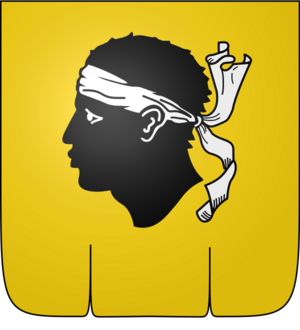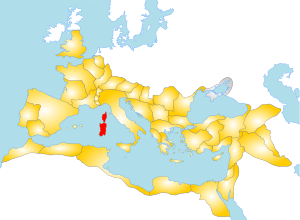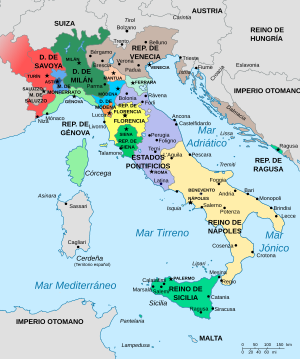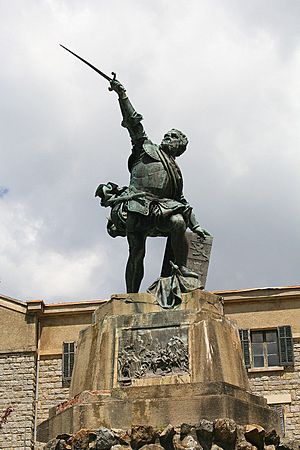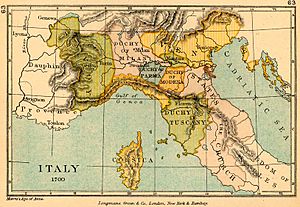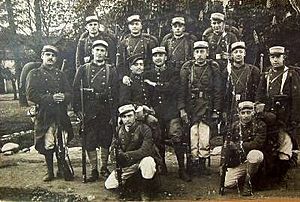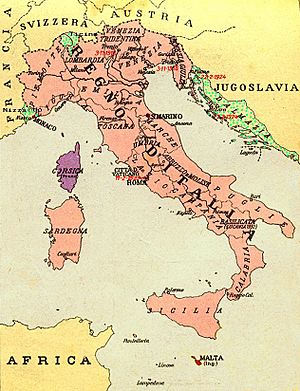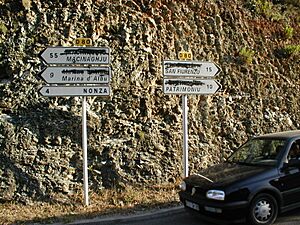History of Corsica facts for kids
The history of Corsica is a long and exciting story! This beautiful island in the Mediterranean Sea has been home to many different groups of people over thousands of years. From ancient times to today, Corsica has seen many changes in who ruled it and how its people lived.
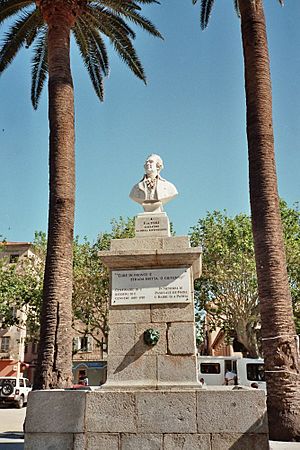
Ancient Greeks knew about Corsica as early as the 6th century BCE. Back then, people from Phoenicia lived there. Later, the Etruscans and Carthaginians took over. The powerful Roman Republic arrived in 237 BCE during the Punic Wars.
After the Romans, the Vandals took control in 430 CE, followed by the Byzantine Empire about a century later. For two centuries, different groups raided the island. In 774, Charlemagne and the Holy Roman Empire conquered Corsica, fighting against the Saracens.
After a time of local rulers fighting each other, the island was given to the papacy (the Pope). Then, Italian city-states like Pisa and Genoa ruled Corsica for 500 years.
In 1755, Corsica became independent as the Corsican Republic. But France took control in 1768 after a treaty. After the French Revolution in 1789, Corsica was briefly a kingdom with Great Britain. But it returned to French rule in 1796.
Corsica strongly supported the Allies in World War I. Many Corsican soldiers fought bravely. After the war, many people moved to southern France because of money problems. Some wealthy Corsicans even became colonizers in places like Algeria.
During World War II, Corsica was part of the French area controlled by the Vichy regime. Italy occupied the island in 1942, and then German forces took over in 1943. The French Resistance fought back, and the Germans left by October 1943. Corsica then became an important Allied air base.
Since the war, Corsica has become a popular place for tourists. It is also known for its movements that want more independence from France.
Contents
Ancient History of Corsica
The story of Corsica begins a very long time ago, in the Upper Paleolithic period. This is the time before written history. The first historical event for Corsica was when the ancient Greeks founded the city of Aléria in 566 BCE.
Where is Corsica?
Corsica's history has been shaped by its location in the middle of the western Mediterranean Sea. It is very close to other lands:
- Only 12 km (7.5 miles) from Sardinia.
- About 50 km (31 miles) from the Isle of Elba.
- About 80 km (50 miles) from the coast of Tuscany in Italy.
- About 200 km (124 miles) from the French city of Nice.
Corsica is the fourth largest island in the Mediterranean. It covers about 8,778 square kilometers (3,389 square miles).
Corsica's Name in Ancient Times
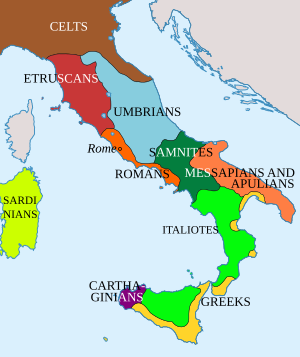
The ancient Greeks, like the historian Herodotus, called the island Kurnos or Kyrnos. The name Corsica is Latin and was used by the Roman Republic.
Historians believe that the name Corsica was the island's native name. They also thought that the first people living there were from a group called the Ligures.
Early Settlers: Phoenicians and Greeks
According to Herodotus, the Phoenicians were the first to settle on the island. Later, Ionian Greeks started a settlement at Aléria in 566 BCE.
However, the Greeks were forced out by an alliance of the Etruscans and the Carthaginians after a battle around 540-535 BCE. The Etruscans and then Carthage controlled the island.
Corsica Under Roman Rule
The Roman Republic took over Corsica in 237 BCE during the Punic Wars. The Romans had a big impact on the island. They built settlements along the coast and spread inland. They also changed the local language to Latin.
Corsica remained under Roman rule until the Vandals conquered it in 430 CE. The Byzantine Empire took it back in 534 CE, bringing some Greek influence.
Corsica in the Middle Ages

After the fall of the Western Roman Empire, Corsica faced many attacks. Groups like the Vandals and pirates raided the island. People moved away from the coast to live in the mountains for safety. This was also because of widespread malaria near the coast.
In 534, the armies of Justinian I brought Corsica back into the Byzantine Empire. But the Byzantines struggled to defend the island from raids by the Ostrogoths, Lombards, and Saracens. The Lombards conquered the island around 725 CE.
The Lombards did not rule Corsica for long. In 774, the Frankish king Charlemagne conquered Corsica. For the next 150 years, the Holy Roman Empire fought the Saracens for control of the island.
After these threats ended, Corsica had a period where local nobles fought each other for power. In 1077, the island was given to the papacy (the Pope). The Pope then gave control to Pisa in 1090.
However, Pisa and its rival, Genoa, soon began fighting over Corsica. These two powerful trading cities clashed for control of the western Mediterranean. Corsica was finally added to the Papal States in 1217 to stop the fighting.
Corsica in the Renaissance
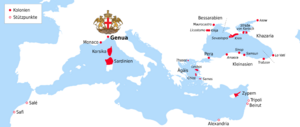
Pisa controlled Corsica for most of the Middle Ages. But at the start of the Renaissance, Genoa took control in 1284 after winning the battle of Meloria against Pisa.
Corsica was part of the Republic of Genoa for 500 years. Even though Aragon and France briefly took over, Genoa kept control until the Corsican Republic was formed in 1755. France then bought Corsica from Genoa in 1768.
The Bank of Saint George
The rulers of Genoa sometimes struggled to govern Corsica well. During these times, powerful Corsican families fought each other. The Bank of Saint George became involved because it was a major lender to Genoa. The bank was given the right to collect taxes in Corsica as security for its loans.
In 1453, the people of Corsica asked the Bank of Saint George for protection. The bank agreed and sent troops to secure important places. They built or rebuilt fortresses and brought Genoese colonists to live in walled cities. These "old cities" still exist today.
Over time, the native Corsicans were allowed to live alongside the Genoese. Peace and order returned to the island. Genoese watchtowers were built all along the coast to guard against raiders and pirates.
Sampiero Corso's Fight for Corsica
The Bank of Saint George, like Genoa before it, became unpopular with some Corsicans. One Corsican exile, Sampiero Corso, became a high-ranking officer in the French army. He convinced French leaders to take Corsica.
In August 1553, a Turkish fleet, allied with France, brought French troops to Corsica. Many cities fell quickly. However, the Turks left in October. Sampiero Corso then started a civil war in central Corsica.
France and Genoa began talks, but Genoa sent its best commander, Admiral Andrea Doria, with 15,000 men. They recaptured many coastal cities. Sampiero continued fighting in the mountains.
Finally, Elizabeth I of England helped arrange a peace treaty. In 1559, the Treaty of Cateau-Cambrésis returned Corsica to Genoa. Sampiero Corso went into exile again.
Corsica in the Enlightenment
The Age of Enlightenment brought new ideas about freedom and self-rule to Corsica. In 1755, Corsica created its own constitution. This made Corsica one of the first places to have an Enlightenment-inspired revolution. It even influenced the American Revolution.
By the 18th century, Corsicans were unhappy with Genoese rule. They thought it was unfair and weak. The Genoese tried to control the island from their fortresses, but the Corsicans used the mountains as their stronghold. Many Corsicans in exile wanted to free their island from all foreign powers.
The Revolts of the 1700s
In 1729, a major revolt broke out in Corsica. Genoa asked the Emperor for military help. The Emperor sent troops, but they struggled to win against the Corsican fighters in the mountains.
A peace agreement was signed in 1732, promising reforms. But Genoa did not keep its promises, and the island revolted again in 1734. In this second revolt, a German adventurer named Theodor von Neuhoff convinced the Corsicans to elect him King Theodore of Corsica in March 1736. He later left to seek support abroad.
The Corsican Republic

A strong leader for Corsican independence finally appeared: Pasquale Paoli. He was a general and a patriot who fought against Genoa and then France. He became known as Il Babbu di a Patria (Father of the Nation).
In 1755, Paoli declared the Corsican Republic. He also founded the first University of Corsica. In 1760, he chose the Moor's head ("Testa Mora") as Corsica's emblem. Paoli believed Corsicans were an Italian people.
Corsica Becomes Part of France
Genoa realized it could not defeat Paoli. In 1764, Genoa secretly sold Corsica to France. French troops slowly replaced Genoese soldiers in the fortresses. In 1768, an open treaty officially gave Corsica to France forever.
The island revolted again. Paoli fought a guerrilla war against the French but was defeated in the Battle of Ponte Novu. He had to go into exile in London. In 1770, France officially announced that Corsica was now part of France.
The Anglo-Corsican Kingdom
After the French Revolution, Pasquale Paoli was seen as a hero of liberty. In 1789, he was invited to Paris and celebrated. He was sent back to Corsica as a high-ranking general.
In 1795, Corsica declared independence again. A new constitution made Corsica a kingdom connected to Great Britain, with a viceroy. This constitution was very democratic for its time, with an elected Parliament. However, the island returned to French rule in 1796.
Modern History of Corsica
19th Century Connections
From 1854 to 1857, the first underwater telegraph cable connected Italy with Corsica. This allowed Paris to communicate with Algeria through Corsica by 1870.
Corsica in World War I
In World War I, Corsica contributed greatly. Out of about 300,000 people, around 50,000 Corsican men joined the army. This was a very high number.
The people of Corsica strongly supported the Allies. Prisoners of war were sent to Corsica and put to work. The island also became a hospital for wounded soldiers.
Corsican soldiers fought bravely, and many were killed or wounded. After the war, this loss of people led to economic problems. Many Corsicans moved to southern France. Some wealthy Corsicans became colonizers in places like Vietnam and Algeria.
Corsica in World War II
After France was defeated in 1940, Corsica became part of the southern zone of Vichy France. This meant it was not directly occupied by Axis forces at first. However, Benito Mussolini, the leader of Fascist Italy, claimed Corsica belonged to Italy. Some Italian-speaking Corsicans also wanted the island to join Italy.
In November 1942, Italy occupied Corsica with a huge force of over 85,000 troops. Later, 12,000 German troops also arrived. The French government stated that the Italian troops were occupiers.
The French Resistance quickly grew in Corsica. Local people and Free French leaders worked together. The Resistance received supplies from Allied submarines and air-drops. They faced harsh treatment from Italian fascist police but grew stronger, especially in the countryside.
In July 1943, after Italy's Fascist government fell, 12,000 German troops came to Corsica. They officially took over the occupation on September 9, 1943, after Italy surrendered. German forces retreated towards the northern port of Bastia. French troops landed in Ajaccio to fight them. The Germans left Bastia by October 4, 1943.
After Corsica was freed, it became an Allied air base in 1944. It supported operations in the Mediterranean and the invasion of southern France. While on the island, U.S. Army engineers successfully got rid of malaria, which had been a big problem in Corsica's coastal areas.
Corsica Today
In recent years, Corsica has become a popular tourist destination. This has brought many immigrants to the island looking for jobs. There have also been movements asking for more self-rule or complete independence from France. Some of these movements have used violence.
In May 2001, the French government gave Corsica limited self-rule. This was an effort to address the calls for nationalism.
In 2013, the famous 2013 Tour de France bicycle race started in Corsica for the first time.
|
See also
 In Spanish: Historia de Córcega para niños
In Spanish: Historia de Córcega para niños


